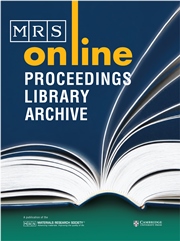Article contents
Processing-Microstructure-Property Relations in AnisotropicThermal Sprayed Composites
Published online by Cambridge University Press: 26 February 2011
Abstract
Thermal spray is a significantly advanced but inherently complex depositionprocess that involves successive impingement of molten droplets on asubstrate to form coating with a ¡°brick-wall¡± layered structure. Theanisotropic microstructure of coatings is very sensitive to processingconditions and has significant influence on the properties. This study aimsto understand the processing-microstructure-thermal property correlation ofthermally sprayed coatings. Thermal transport properties of three coatingsystems forming composites with pores (yttria stabilized zirconia (YSZ)-Air), a second phase (Mo-Mo2C) and a graded material (YSZ-NiCrAlY) areinterpreted from the point of view of microstructure and chemicalcomposition. In the case of YSZ-Air composite, results indicate thatporosity contribution from 20-35% decreases the thermal conductivity by50-70% of the bulk value. For the intrinsic composite of Mo and Mo2C, whichcoexist as stable phases, thermal conductivity increases significantly with1.75wt% carbon addition since it reduces formation of MoO2 duringprocessing, but decreases with 3.5wt% carbon addition. This is attributed tolarger carbide retention in the latter. For the discrete layered and gradedcomposites of YSZ-NiCrAlY, which are made up of varying fractions of thesetwo constituents, thermal conductivity decreases sharply up to 40wt% YSZ andthen more gradually with increasing YSZ content. This paper examines theseexperimental findings by treating the these complex coatings as multiphasecomposites.
Information
- Type
- Research Article
- Information
- Copyright
- Copyright © Materials Research Society 2007
References
- 1
- Cited by

